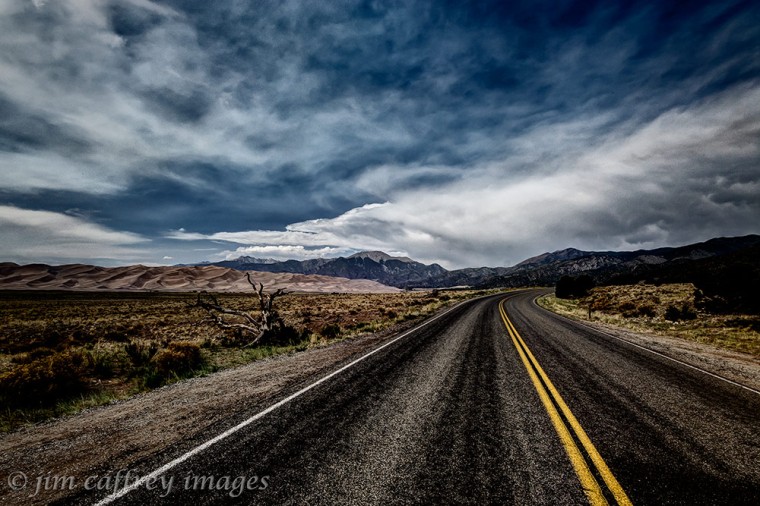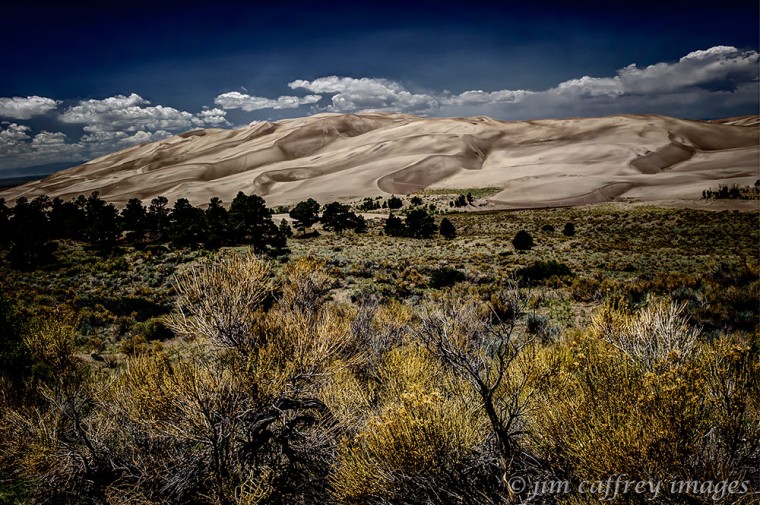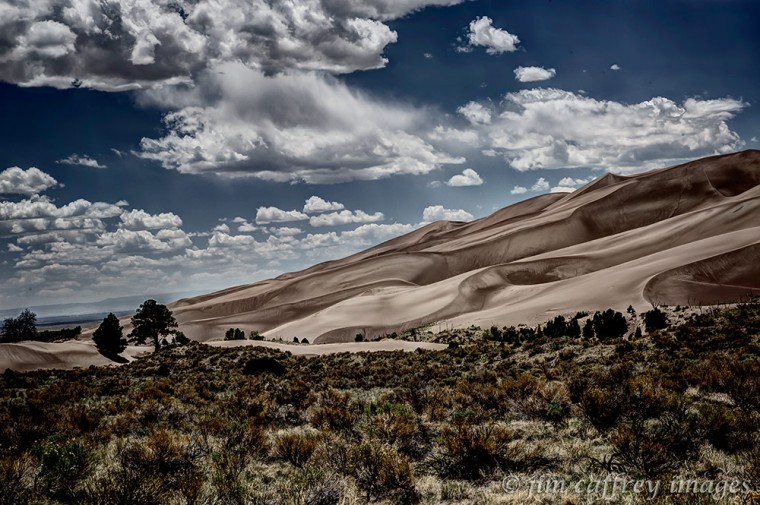Found Memories
I make it a habit to dig into my archives every so often just to see what might jump out at me. I am usualy pleasantly surprised and also find myself wondering why I didn’t see the possibilties of these images back then. The answer is, in most cases, a change in my perspective, or perhaps a maturation of my vision. In other cases, a simple change in long-standing habits, otherwise known as getting out of a rut.
 I was in Lake City, Colorado for the Lake City Wine and Music Festival. After the two day event, I took a ride up the road to Cinammon Pass which summits at nearly thirteen-thousand feet. Somewhere along the way I made this photograph of a stand of aspens. I guess I didn’t think it worthy of any further work when I edited my photos from that trip. I let my expectations get in the way sometimes and when I revisit images later, those biases no longer inhibit my judgement.
I was in Lake City, Colorado for the Lake City Wine and Music Festival. After the two day event, I took a ride up the road to Cinammon Pass which summits at nearly thirteen-thousand feet. Somewhere along the way I made this photograph of a stand of aspens. I guess I didn’t think it worthy of any further work when I edited my photos from that trip. I let my expectations get in the way sometimes and when I revisit images later, those biases no longer inhibit my judgement.
 The shading and texture of these deep erosion channels at the foot of Cainville Mesa caught my eye as we were driving past on the way to Factory Butte. I didn’t have a long telephoto lens with me, so I borrowed my friend Robin’s 70-300 and made this image. I didn’t think anything else about it and skipped right over it when I edited and processed my work from that trip. But looking at it now, I see the things that compelled me to make the photograph in the first place.
The shading and texture of these deep erosion channels at the foot of Cainville Mesa caught my eye as we were driving past on the way to Factory Butte. I didn’t have a long telephoto lens with me, so I borrowed my friend Robin’s 70-300 and made this image. I didn’t think anything else about it and skipped right over it when I edited and processed my work from that trip. But looking at it now, I see the things that compelled me to make the photograph in the first place.
 The coastal redwoods in northern California are an experience. It’s like being transported to another world, at least it seems that way to me, a desert rat who has lived for more than forty years in the desert southwest. This patch of rhododendrons was growing right along the road; the contrast between the delicate leaves and blossoms, and the looming immensity, and mystery of the trees disappearing into the mist in the background captured my imagination.
The coastal redwoods in northern California are an experience. It’s like being transported to another world, at least it seems that way to me, a desert rat who has lived for more than forty years in the desert southwest. This patch of rhododendrons was growing right along the road; the contrast between the delicate leaves and blossoms, and the looming immensity, and mystery of the trees disappearing into the mist in the background captured my imagination.
 I try to do any cropping to an image in camera, in other words, as I’m making the image. I very seldom crop photographs when I’m processing them. But this one was nagging at me. the left side of the image was not doing anything, it was an unwanted appendage. At the same time, I didn’t want to lose too much of the brooding clouds at the top. The answer was to change the aspect ratio from the normal 2:3 of 35mm or, in this case, full frame digital to 4:5. I like the result. The subject is the Yeibichei Rocks in Monument Valley.
I try to do any cropping to an image in camera, in other words, as I’m making the image. I very seldom crop photographs when I’m processing them. But this one was nagging at me. the left side of the image was not doing anything, it was an unwanted appendage. At the same time, I didn’t want to lose too much of the brooding clouds at the top. The answer was to change the aspect ratio from the normal 2:3 of 35mm or, in this case, full frame digital to 4:5. I like the result. The subject is the Yeibichei Rocks in Monument Valley.
 I often go to Tucson in February or March to photograph the blooming desert. In a good year, the wildflowers carpet large parts of the desert landscape. I remember very clearly the making of this image. This saguaro cactus was right across a dirt road from where my campsite was located. The sun had just set and, in the twilight’s glow, the clouds were a salmon color. This particular cactus was probably thirty feet tall and in order to isolate it, I had to be pretty close (once again, I found myself without a long telephoto lens. I have since started bringing at least my 80-200 Nikkor along on all my trips). The point is that the farther away you can get from a tall subject such as this, the less vertical perspective will be obvious in the image. I was able to do some correction in Lightroom, but I would rather make the corrections during the making of the photograph.
I often go to Tucson in February or March to photograph the blooming desert. In a good year, the wildflowers carpet large parts of the desert landscape. I remember very clearly the making of this image. This saguaro cactus was right across a dirt road from where my campsite was located. The sun had just set and, in the twilight’s glow, the clouds were a salmon color. This particular cactus was probably thirty feet tall and in order to isolate it, I had to be pretty close (once again, I found myself without a long telephoto lens. I have since started bringing at least my 80-200 Nikkor along on all my trips). The point is that the farther away you can get from a tall subject such as this, the less vertical perspective will be obvious in the image. I was able to do some correction in Lightroom, but I would rather make the corrections during the making of the photograph.
 Here is another photograph from one of my Arizona springtime trips. I had read about crested or cristate saguaros and set about finding one. A crested saguaro is a mutation which causes the cactus to fan out, usually at its head. The mutation is thought to be caused by some event (a lightning strike, or possibly a freeze) which interferes with the plant’s normal growth.
Here is another photograph from one of my Arizona springtime trips. I had read about crested or cristate saguaros and set about finding one. A crested saguaro is a mutation which causes the cactus to fan out, usually at its head. The mutation is thought to be caused by some event (a lightning strike, or possibly a freeze) which interferes with the plant’s normal growth.
 I’m not sure why this photograph escaped me during the first go round. I made the image on my first visit to Bandon Beach. I had been looking forward to photographing there and I spent an entire morning moving up and down the beach making pictures. None of those images met my expectations at the time; this one languished in my archives until just recently. There’s a moral to this story: take the time to review your archived images. There are probably some gems waiting there for you to finally recognize their potential.
I’m not sure why this photograph escaped me during the first go round. I made the image on my first visit to Bandon Beach. I had been looking forward to photographing there and I spent an entire morning moving up and down the beach making pictures. None of those images met my expectations at the time; this one languished in my archives until just recently. There’s a moral to this story: take the time to review your archived images. There are probably some gems waiting there for you to finally recognize their potential.
To B&W Or Not To B&W
What is it about a black and white image that fires our imagination? How does the removal of color from an image have such profound effect on what that image says to the person viewing it? In this post I am going to look at three of my photographs and discuss how the black and white versions differ from their color counter-parts.
This first image was made at Ah Shi Sle Pah Wash in New Mexico’s San Juan Basin. The gibbous moon was riding low in the sky and I captured its transit behind this rock formation. In the color version, while the moon is still center stage, it is overpowered by the strong contrast between the complimentary colors in the sky and the orangish brown rock.
In the black and white image, the moon regains its prominence; even though it is relatively small in the photo, the contrast between it and the dark sky gives it some visual weight in the frame. The foreground is suddenly more about the mudstone supporting the rock, again because of the lighter tones in that part of the image.
Another element that benefits from a black and white conversion is a textured pattern. This image of the cracked earth near the Eagle’s Nest in the Bisti Wilderness does pretty well in color, but when converted to black and white, the texture in the foreground becomes more prominent.
The image is suddenly more about the dry cracked earth which was my intent.
Sometimes it’s more about the overall feel of the image. This last photo of the Cumbres-Toltec was made as the train was crossing the bridge over the Chama River. I like the color version but the mood isn’t quite right. By converting the image to black and white and then adding a sepia split tone, I was able to pull the image together and give it a more somber voice.
There are many ways to accomplish a monotone conversion using Photoshop, Lightroom, or any of the other image editing applications that are available. The most important part of the process, I believe, is having the ability to control the tones as they relate to the colors in the original image. By using the B&W adjustment layer in Photoshop instead of a greyscale conversion (which dumps all of the color information), or the HSL sliders in Lightroom you can adjust these tones individually and your results will have more visual punch.
Train Tag
For the past month I have been learning to play the fascinating sport of train tag. It involves learning the route and the timetable of a certain train that runs between Antonito, Colorado and Chama, New Mexico. After becoming familiar with these elements, the next step is to drive from one point to another along the train’s route; the trick being to arrive at the next place in time to set up a shot before the subject arrives. After several weeks practice, I became pretty adept at getting to the good spots and making the images I wanted.
I made this image the first day I went up to try to get some fall photos of the train . It was mid September, way too early for fall color. I’m glad I went though, because it took several tries to get it right. The more I worked the scenes, the more intimate I became with the environment and the train’s schedule. As a landscape photographer, I rarely need to worry about time restraints, so this was a good experience for me.
The second image was made at the beginning of October. The leaves were just starting their transformation and I noticed that some of the trees were pretty dull, going almost immediately to brown. I’m not sure, but I think it has to do with the greater than usual scarcity of moisture we’ve been experiencing here in the southwest.
Fast forward another week and I finally found what I was looking for; the aspens had reached peak color. Even though some of them were still wearing green, I knew that this was probably the optimal time, so I had to make the best of it. This image shows the train making its way through an aspen grove about five miles north of Chama.
Farther up the route, the color was already gone and the first snow was beginning to cover the ground. I figured the same would be true at the lower altitudes within a few days, so this had to be it. It was also the end of the season for the train so this definitely had to be it.
To finish things off I wanted to capture the train approaching its destination (in this case Chama), so I began looking around and with Robin’s help, managed to find this trestle about a half mile north of the station. We raced the train down through the canyon stopping to photograph at all the good vantages and then made a mad run for the road that brought us close to the trestle. We had to make it in time to run across the trestle ahead of the train to get the image I wanted, but it was well worth the effort.
As the train came closer, I chickened out and moved from the center of the tracks before I made this final image.
The Great Sand Dunes
The Great San Dunes National Park in southern Colorado is one of those places that take you by surprise, at least it did me. All of the images I had seen of the place did not prepare me for the actual experience. You begin to see the dunes from quite a distance, and they grow ever larger as you draw closer.
With the Sangre de Cristo Mountains as a backdrop, the visual contrast is immediately evident. The rugged peaks of the range make the dunes appear soft and sensual.
But the contrasts don’t stop there. The interface of the sand dunes with the surrounding ecosystems teem with biodiversity. There is sage, and there are ponderosa pines. There is a perennial stream (Medano Creek) which serves to return the sand which is blown off the dunes and into the mountains back to the base of the dune field. And, of course there is an abundance of wildlife, from the small to the large, insects and prairie dogs to deer and mountain lions.
Then there are the dunes themselves which tower as high as six hundred and fifty feet above the valley floor. It is an almost surreal scene; imagine part of the Sahara Desert dropped into the middle of the Rocky Mountains.
As you move from one zone to the next, it is a subtle thing. The ecosystems are feathered into one another so there is no definite boundary, but from certain perspectives, the change can seem abrupt.


















